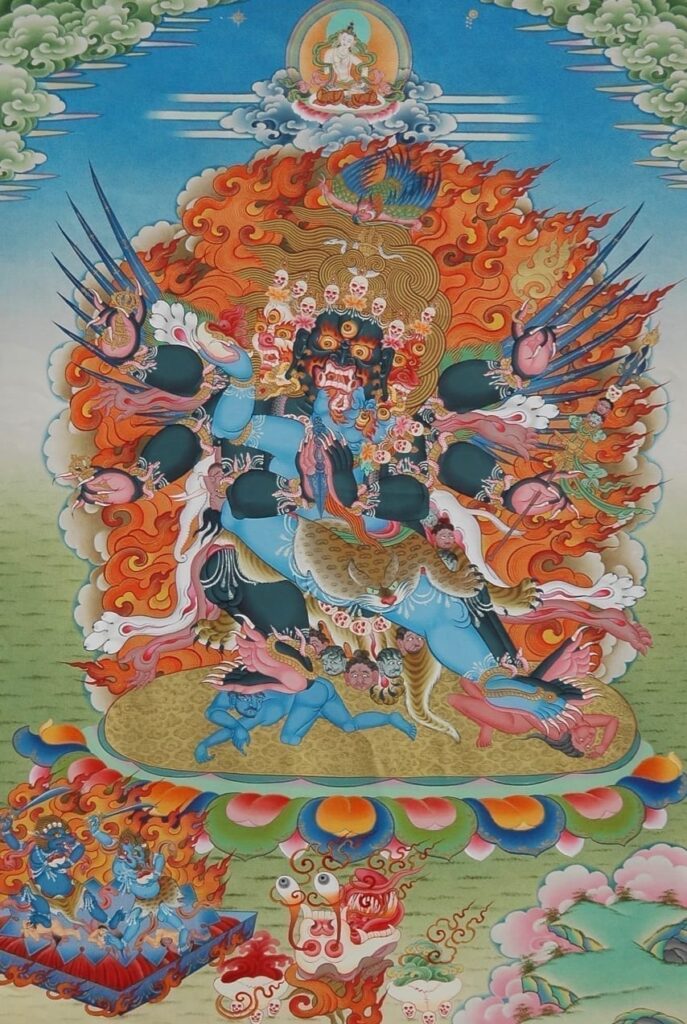Significance
Vajrakilaya, the wrathful form of Vajrasattva, is the yidam deity who embodies the awakened activity of all buddhas and whose practice is famous for being the most powerful for removing obstacles, destroying forces hostile to compassion, and purifying the spiritual pollution so prevalent in this age.
History
In Ancient India, many practitioners reached accomplishment through the teachings and practices of Vajrakilaya. The vidyadhara Prabhahasti, one of Guru Padmasambhava’s main teachers, eventually synthesized the oral and later treasure teachings, revealed at the Sitavana charnel ground, of Vajrakilaya. Prabhahasti passed all the teachings on to his foremost disciple Guru Padmasambhava. It was however not until later in Nepal that Guru Padmasambhava disclosed the full power of the Vajrakilaya teachings.
This event, as told in the biographies of Guru Padmasambhava, begins with the Mahaguru directing his intention toward the supreme realization of mahamudra. In searching for a suitable retreat place, the Mahaguru traveled to Nepal where he met his destined consort, Belmo Shakyadevi, in a charnel ground below the Swayambhu Stupa. They continued south to the rocky caves of Pharping. Here Guru Rinpoché first opened the mandala of Yangdak Heruka with Shakyadevi beside him, and so they began their retreat.
No sooner had Guru Padmasambhava settled down to practice with his consort than they were beset by powerful demons. These forces plunged the whole country into a state of famine, plague, and chaos. For three years, these forces put a stop to the rains, so that famine, disease, and suffering spread like wildfire throughout India, Nepal, and Tibet, killing humans and livestock alike. These were desperate times for the region, and indeed it is often said that the more profound the practice, the more menacing the obstacles.
With havoc spreading all around, the Mahaguru decided to call upon his Indian gurus for remedial measures. He dispatched two Newar heart disciples—Jinamitra of Swayambhu and Lady Kunla Kunsashi—to Nalanda, in India, to ask for practices to counteract the virulent work of the demons. In their quest, they finally reached one of the Mahaguru’s own gurus, the vidyadhara Prabhahasti, and he gifted the two messengers the precious volumes they sought. The Newar disciples hastened back, laden with tantras and commentaries on Vajrakilaya, the deity that embodies the Buddha’s enlightened activity. The mere physical presence of these texts approaching ever closer had an immediate effect, instantly quelling the demonic tide that was sweeping through the land. All the proper conditions were finally in place: a destined spiritual consort, the ideal set of practices, and the perfectly chosen place. For three weeks, the Mahaguru and Belmo Shakyadevi practiced in Asura Cave. Together they invoked Vajrakilaya, thereby eradicating all obstacles to the accomplishment of mahamudra.
A rain of kila daggers fell from the sky, some still visible to this day as black kila rock formations around the caves, and realization was won. The terrors that had plagued the land were instantly transformed into the most delightful situations: timely rains, bountiful harvests, healthy animals, and healthy people. It is said, “When you are able to remove all obstacles, there remains no doubt that all siddhis will come.” Indeed, Guru Padmasambhava had attained his highest level of realization yet.1Padmasambhava. Following in Your Footsteps: The Lotus-Born Guru in Nepal. Ed. Lhasey Lotsawa. Rangjung Yeshe Publications: Kathmandu, 2019, pp. 145-150.
Later, Guru Rinpoché was joined at Yangleshö by the Kashmiri pandit Vimalamitra and the Newar yogi King Shilamanju. Once each of them had attained signs of accomplishment in their practice of Vajrakilaya, these three masters discussed and compiled all the Vajrakilaya teachings they had received, principally from the teachers Indrabhuti, Dhanasamskrita, Shri Singha, and Prabhahasti. The three masters accordingly revised and systematized the teachings on Vajrakilaya.
In the Barché Lamsel prayer, we find praise for Guru Rinpoché as the Pandita of Yangleshö. This is the Mahaguru as Mawé Sengé, Lion of Speech, indivisible from Manjushri, invoked in recognition of his extraordinary feats of composition that occurred here at Yangleshö.
Henceforth, Guru Padmasambhava used the practice of Vajrakilaya to bring down troublesome spirits and bind them to his command, not only here at Yangleshö and Asura, but elsewhere throughout Nepal, India, and Tibet.
After Guru Padmasambhava had firmly established Buddhism within Tibet, he passed the teachings of Vajrakilaya to Khandro Yeshe Tsogyal and his foremost disciples, who in turn transmitted the teachings orally and hid them as treasures. Thus, the Vajrakilaya teachings spread within Tibet, and many practitioners reached accomplishment through the practice of Vajrakilaya.
The Sangtik Phurba practice belongs to the treasure teachings hidden by Guru Padmasambhava for future disciples. In the late summer of 1859, at the retreat hermitage of Jamgön Kongtrul Rinpoche at the sacred site of Tsadra Rinchen Drak in Tibet, Chokgyur Dechen Lingpa revealed the practice of Sangtik Phurba as part of the three inner secret essence cycles of Vajrasattva, Yangdak Heruka, and Vajrakilaya together with sacred treasure substances. Among the Vajrakilaya revelations of Chokgyur Lingpa, Sangtik Phurba is considered the highest or Atiyoga practice of Vajrakilaya. Because it is very effective in remove obstacles, contains great blessings, yet is easy to practice, it became the main yidam for all the Choklings.
Further Reading
More information about the practice of Vajrakilaya can be found here:
- Chokgyur Lingpa. Powerful Transformation: The Alchemy of the Secret Heart Essence. Ed. Marcia Schmidt. Rangjung Yeshe Publications: Leggett, 2017.


